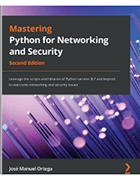How to get started with socket programming for beginners
To understand socket programming for beginners, basic network and security concepts are critical -- and having Python skills won't hurt, either. Learn more in this expert Q&A.
A socket is an endpoint in communication between networks, and socket programming enables these endpoints to transfer data, thereby supporting communication between networks and programs. Socket programming, for beginners, can play a major role in understanding how networks communicate.
Socket programming has several benefits, such as aiding in real-time connectivity, and can use a variety of programming languages. One of the popular programming language options is Python, which is a common language that networking professionals will encounter in their careers. While Python isn't the only language beginners should learn for socket programming, it has various tools and modules to help handle packets and provides both high- and low-level methods of handling sockets, according to author José Manuel Ortega.
Ortega's book, Mastering Python for Networking and Security Second Edition, explores Python's libraries and scripts for networking and security and explores aspects like HTTP and socket programming for beginners to become masters.
Editor's note: The following interview was edited for length and clarity.
What are common questions asked about socket programming for beginners?
José Manuel Ortega: The most common questions for beginners are related to the utilities of sockets at a high level about what libraries we can use in programming languages, like Python [and] C/C++, and at a low level how the operating system uses it for communications between applications.
In the end, I believe it does not depend so much on the libraries with which one works, depending on their programming language or operating system. In the end, it depends more on the concepts one has about networks and security and how one could solve a specific problem without having to know a library or a specific language.
Libraries and languages like Python are [tools] that help you reach a solution, but they do not give you a solution by themselves, since you need to have a basis on networks [and] how protocols and operating systems work. Learning a certain library or programming language comes later and is not the most important thing.
If someone asks me more specifically about libraries we have in Python, I would recommend the ones I analyze in the book. Depending on the language you are most comfortable with, you will have different alternatives, and I would recommend trying other languages that offer better performance, such as C/C++.
 José Manuel Ortega
José Manuel Ortega
What are the benefits and challenges of socket programming for networking and security?
Ortega: From a networking point of view, we could use sockets to implement a client-server application -- for example, a chat. From a security point of view, sockets are used at a low level to determine the ports that a machine has open, and typical port scanner tools, such as Nmap, use them at a low level. They can also be used to connect to an external server using a reverse shell in the same way that we can use the SSH [Secure Socket Shell] command.
The main challenges are related to being able to make requests asynchronously -- for example, with the python-socketio project, you can implement clients, applications and servers that can be integrated with Python web frameworks, like Flask.
How much does socket programming differ from Transmission Control Protocol (TCP) to User Datagram Protocol (UDP)?
Ortega: The main difference between TCP and UDP is that TCP is connection-oriented. This means [it] is guaranteed our packets will reach their destinations, with error notifications if packet delivery fails. On the other hand, UDP … is suitable for applications that require efficient communication that don't have to worry about packet loss.
The main difference between working with TCP and UDP in Python is that, when creating the socket, you have to use SOCK_DGRAM for UDP and SOCK_STREAM for TCP.
Why should a network professional use Python for socket programming over another language?
Ortega: Python provides the socket module required to work with sockets at high and low levels. The socket module provides all the required functionalities to quickly write TCP and UDP clients and servers.
Python also offers other tools for the manipulation of network packets -- like Scapy, [which] is a module written in Python to manipulate packets with support for multiple network protocols. This tool allows the creation and modification of network packets of various types, implementing functions for capturing and sniffing packets.
Also, its learning curve is low if we compare it [to] programming with languages like C/C++.
What's driving the implementation of socket programming? Are there any viable alternatives?
Ortega: The main advantage provided by sockets is that they have the ability to maintain the connection in real time and we can send and receive data from one end of the connection to another. For example, we could create our own client-server application that allows us to receive and send messages in real time, processing these messages in an asynchronous way.
The main alternative to the use of sockets within Python we can find [in] the asyncio module that allows us to execute asynchronous calls concurrently with the aim of launching requests in parallel.








